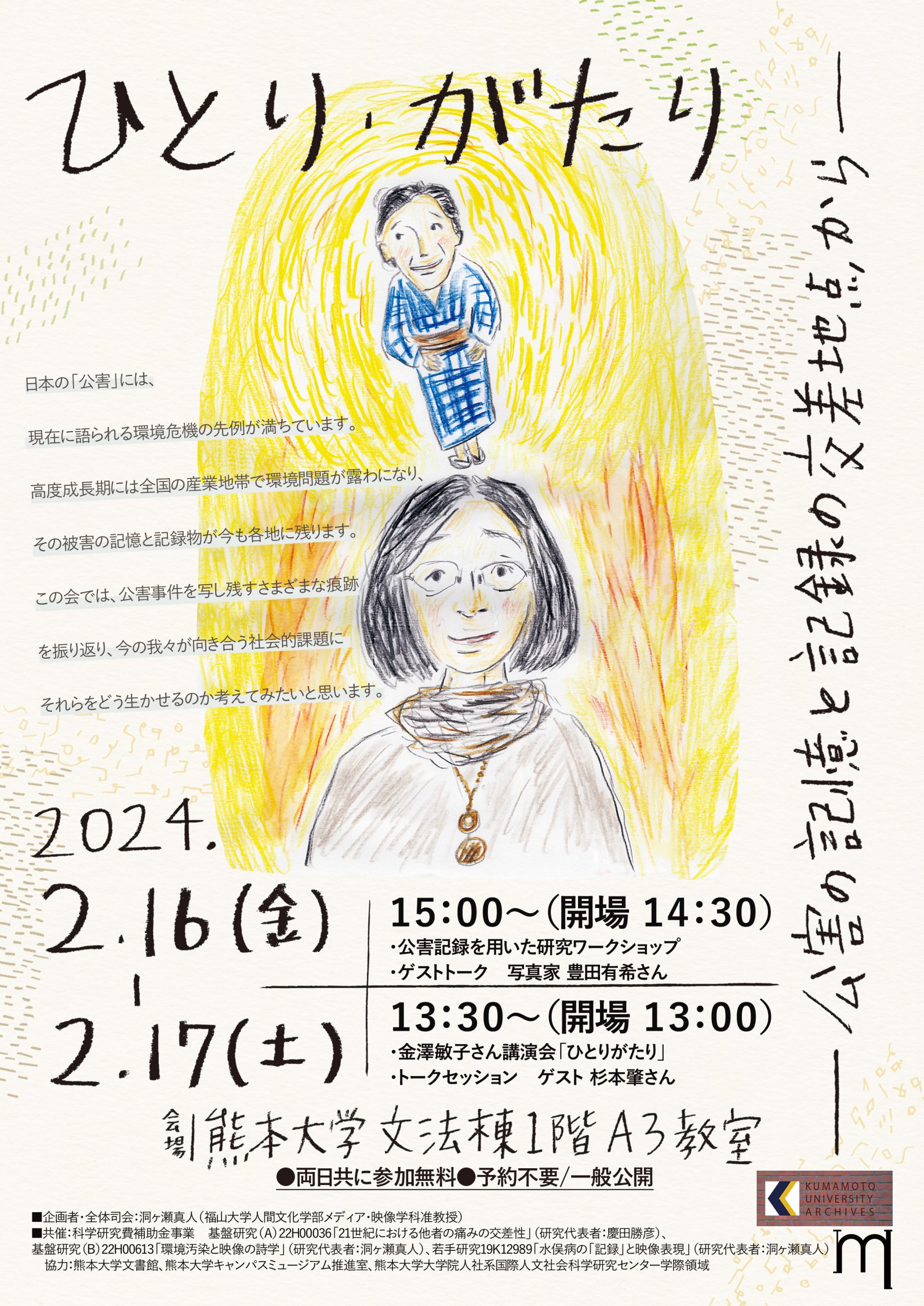- Home
- News & Event
- We will hold a public seminar “A Solitary Story: From the intersection of memories and records of pollution”
We will hold a public seminar “A Solitary Story: From the intersection of memories and records of pollution”
Japan’s “pollution” is full of precedents for environmental crises that are being talked about today. During the period of high economic growth, environmental problems were exposed in industrial areas across the country, and memories and records of the damage still remain in various places today. At this meeting, we will look back at the various traces left behind by pollution incidents and consider how we can use them to address the social issues we face today, through the stories of each participant.
◆On February 16th (Friday), researchers will be on stage at a workshop to consider the use of pollution records for research. A talk by photographer Yuki Toyoda is also planned.
◆The main event, Saturday, February 17th, will feature a “Hitorigatari” lecture by guest lecturer Toshiko Kanazawa (born 1951, living in Toyama Prefecture). Ms. Kanazawa worked as a Northern Japan Broadcasting announcer and has produced over 40 TV and radio documentaries, and in recent years he has been telling the life story of Miyo Komatsu, the lead plaintiff in the Itai-Itai disease lawsuit. There will also be a talk session with Mr. Hajime Sugimoto, the storyteller of the Minamata Disease Museum.
*Please see the flyer PDF for program etc.
*There is a charge for parking on the university campus, so please use public transportation as much as possible.
[Date and time] February 16, 2023 (Friday) 15:00-18:30/ February 17th (Saturday) 13:30-16:20
[Place] Classroom A3, 1st floor, Grammar Building, Kurokami Kita District, Kumamoto University (2-40-1 Kurokami, Chuo-ku, Kumamoto City)
[Target] General public (anyone who is interested)
[Participation fee] Free, no reservation required
[Sponsored by] Grants-in-Aid for Scientific Research (A) 22H00036 “Intersectionality of Other People’s Pain in the 21st Century” Representative: Katsuhiko Keida (Kumamoto University) / Grant-in-Aid for Scientific Research (B) 22H00613 “Environmental Pollution and the Poetics of Imagery” ”, Young Researcher 19K12989 “Records” and Visual Expressions of Minamata Disease Representative: Masato Horogase (Fukuyama University)
[Cooperation] Kumamoto University Archives, Kumamoto University Campus Museum Promotion Office, Kumamoto University Graduate School of Humanities and Social Sciences International Research Center for Humanities and Social Sciences Interdisciplinary Area
[U R L] Archives Homepage Notice – Kumamoto University Archives (kumamoto-u.ac.jp)
[Guest lecturer] Toshiko Kanazawa
Born in 1951. She lives in Nyuzen-cho, Toyama Prefecture. After working as a Northern Japan Broadcasting announcer, she has produced over 40 documentaries for television and radio. She has written many books about Itai-itai disease, rice riots, and the Tomari/Yokohama Incident, including the picture book ”Miyo-san’s Fight and Wish.” In recent years, she has been telling the ”solo story” of Miyo Komatsu, the lead plaintiff in the Itai-Itai disease lawsuit, about her life full of hardships. In her lecture, she will introduce the suffering, sadness, and anger of patients, as well as the 66-year life of Miyo Komatsu, who continued to fight against Itai-itai disease, using Toyama dialect.
[About Itai-Itai disease]
One of the four major pollution diseases. From around the end of the Meiji era, residents of the Jinzu River basin in Toyama Prefecture were affected by drinking water and rice contaminated with cadmium contained in wastewater from the Mitsui Kinzoku Kamioka Mine in Gifu Prefecture. It mainly occurs in older women, and when the heavy metal cadmium accumulates in the body, it can cause kidney damage and cause bones to soften and break easily. It got its name because patients complained of severe pain, saying, ”It hurts, it hurts.” In 2022, the 201st patient was confirmed under the patient recognition system.

[inquiry]
Kumamoto University Archives
2-39-1 Kurokami, Chuo-ku, Kumamoto 860-8555 (South Campus)
Phone: 096-342-3951
FAX: 096-342-3952
e-mail: archives※jimu.kumamoto-u.ac.jp
(@ has been replaced with * to prevent spam)










